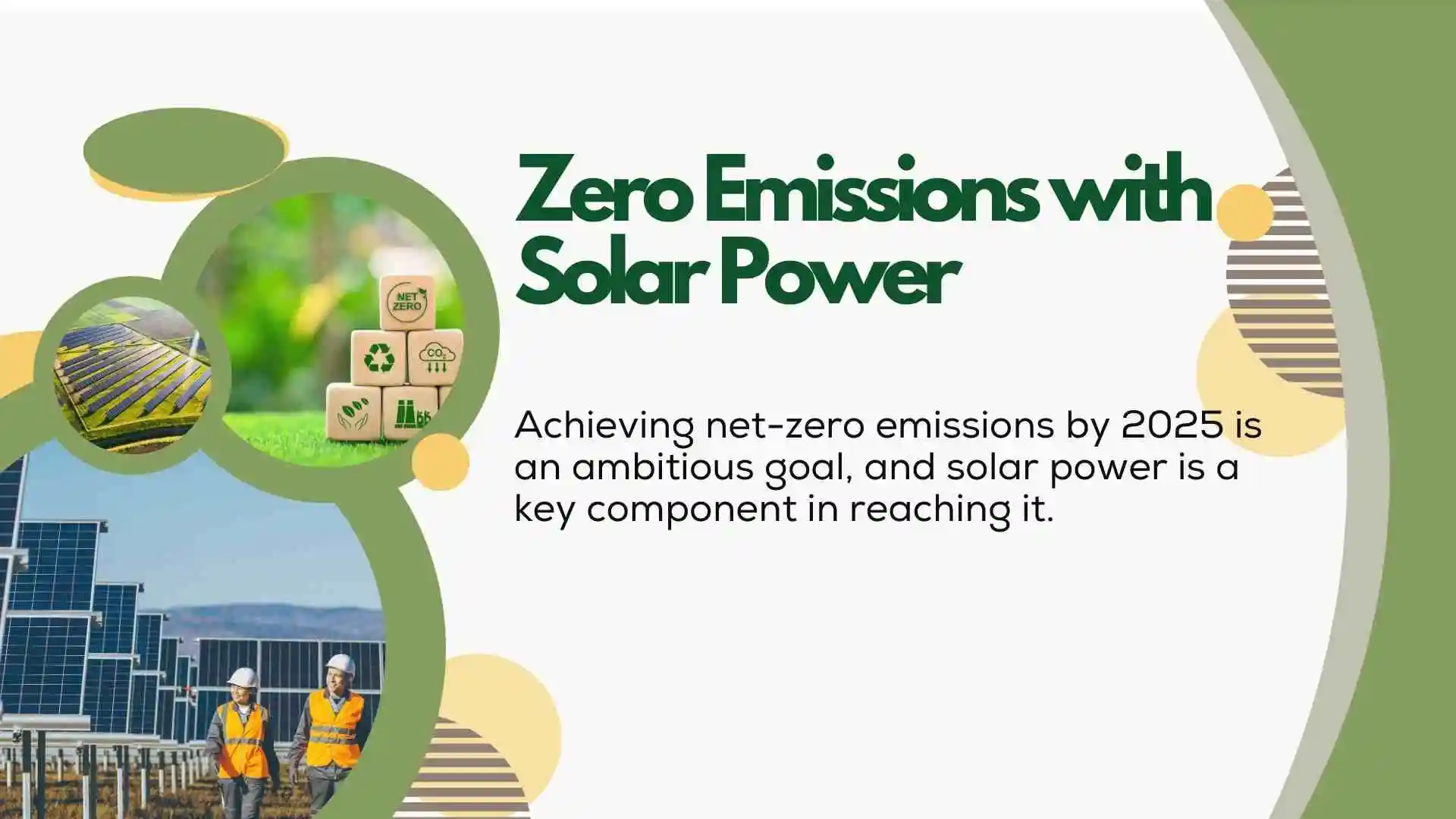Achieving Solar Energy Zero Emissions in 2025
The world faces the urgent need to combat climate change. Solar energy zero emissions is a key solution to this problem. Solar power helps reduce carbon footprints and reliance on fossil fuels. It is a clean, renewable energy source that can power homes, businesses, and cities. By adopting solar energy zero emissions, we move closer to a sustainable future.

Solar power is harnessed from the sun’s energy. It does not release harmful gases like CO2. This makes it a vital tool in achieving zero emissions. As the demand for energy grows, solar energy can meet that demand without harming the planet.
If you want to know complete details about solar PV system then please visit Solar Photovoltaic.
What Is Solar Energy Zero Emissions and How Does It Contribute?
Solar energy captures energy from the sun and turns it into electricity using solar panels. This process produces no harmful pollutants or greenhouse gases. As a result, it plays a key role in achieving zero emissions goals. By using solar energy zero emission, we can cut down on the need for fossil fuels. Fossil fuel-based power generation is responsible for a large portion of carbon dioxide (CO2) emissions. Reducing this reliance is essential in the fight against climate change.
| Energy Source | Emission Impact |
|---|---|
| Solar Energy | Zero emissions |
| Coal | High emissions |
| Natural Gas | Moderate emissions |
| Wind | Zero emissions |
The Role of Solar Power in Sustainable Energy Solutions
Solar energy zero emission refers to harnessing solar power as a renewable energy source to achieve a carbon-free energy grid. Solar panels capture sunlight and convert it into electricity without emitting harmful gases, making it a key player in the pursuit of zero emissions. By shifting to solar power, we reduce our dependence on fossil fuels, which are major contributors to global warming.
Solar Energy’s Impact on Reducing Carbon Footprints
The zero emissions concept is rooted in reducing carbon footprints. Solar power systems produce electricity without the direct emission of CO2 or other pollutants. This has a profound impact on reducing air pollution and decreasing greenhouse gases in the atmosphere. As more individuals and companies switch to solar, the collective impact becomes a significant step toward achieving global zero emissions targets.
Benefits of Switching to Solar Power for Zero Emissions Goals
It offers numerous benefits. The environmental advantages include cleaner air, reduced greenhouse gas emissions, and preservation of natural resources. Financially, solar power allows consumers to save money in the long term due to reduced energy costs and available government incentives.
| Benefit | Explanation |
|---|---|
| Environmental Impact | Reduces CO2 emissions and air pollution. |
| Financial Savings | Lower energy bills and incentives reduce installation costs. |
| Energy Independence | Less reliance on fossil fuels and grid energy. |

Environmental and Financial Benefits of Solar Energy
Adopting solar energy zero emissions can significantly reduce environmental impact, cutting down on air and water pollution. Financially, solar installations offer long-term savings by reducing energy bills and providing returns on investment. With the right incentives and government support, switching to solar becomes a financially viable option for many.
Long-Term Savings with Solar Power Installations
The long-term savings from solar energy zero emissions go beyond just energy bills. While the initial installation cost can be substantial, the return on investment is usually seen within 7-10 years. With decreasing installation costs and available incentives, the financial benefits of solar power have never been more accessible.
Key Features of Zero Emissions Solar-Powered Buildings
Zero emissions solar-powered buildings are designed to produce all or most of their energy needs from renewable sources like solar energy. These buildings feature a combination of sustainable materials, energy-efficient systems, and innovative technologies to minimize their carbon footprint and energy consumption. The integration of solar energy systems is key to achieving it.

Solar Panels and Battery Storage in Zero Emission Homes
Battery storage systems, when paired with zero emissions systems, allow homeowners to store excess energy produced during the day for use at night or during cloudy weather. This makes solar energy a reliable source of power for zero-emissions homes, ensuring they remain independent from the grid.
| Feature | Description |
|---|---|
| Solar Panels | Capture sunlight and convert it into electricity, reducing reliance on the grid. |
| Battery Storage | Stores excess solar power for later use, ensuring consistent energy supply throughout the day. |
Smart Energy Management with Solar Technology
Smart energy management systems, integrated with solar energy zero emissions setups, optimize energy use within the building. These systems monitor energy production and consumption, making adjustments to maximize efficiency and minimize waste, which helps in achieving zero emissions.
How Solar Energy Can Help You Achieve Your Zero Emissions Target
Solar energy zero emissions plays a crucial role in achieving clean energy transitions. By embracing solar, countries can work toward their zero-emission goals while reducing global warming. The future of energy relies on renewable sources like solar power to ensure a healthier planet.
| Action | Impact on Zero Emissions |
|---|---|
| Switch to Solar | Reduces carbon emissions from electricity generation. |
| Increase Solar Installations | Accelerates progress toward zero-emission goals. |
| Adopt Solar Incentives | Reduces upfront costs and increases solar adoption. |

Understanding Solar’s Role in Clean Energy Transitions
Solar energy zero emissions is a critical component in the transition to clean, renewable energy. Solar power helps achieve zero emissions by replacing the need for fossil-fuel-based energy, which is responsible for significant levels of carbon emissions. By investing in solar energy, countries and businesses can meet their renewable energy goals and lower their emissions over time.

Real-World Examples of Zero Emissions Achieved with Solar Power
Numerous cities and companies worldwide have already started achieving solar energy zero emissions targets. For instance, Los Angeles and Dubai are expanding their solar capacities to meet environmental targets. These real-world examples show that solar energy is an effective solution for reducing emissions and achieving sustainability goals.
Common Challenges in Achieving Zero Emissions with Solar Energy
Despite the growing adoption of solar energy zero emissions, there are still challenges such as initial costs, limited access to financing, and lack of awareness about the benefits. Overcoming these challenges requires commitment from governments, businesses, and individuals.
| Challenge | Solution |
|---|---|
| High Initial Costs | Government incentives, tax credits, and financing options. |
| Limited Knowledge | Public education campaigns and solar energy awareness. |
| Access to Financing | More flexible loan and leasing options for solar power. |
Overcoming Barriers to Solar Power Adoption
Despite the benefits, several challenges exist in achieving solar energy zero emissions, such as high initial costs, limited access to financing, and a lack of public knowledge. Overcoming these barriers requires strong policy support, government incentives, and increased awareness about the long-term savings and environmental benefits of solar power.
What to Consider Before Making the Switch
Before committing to solar energy zero emissions, it’s important to consider factors like roof space, local weather conditions, energy usage, and budget. Evaluating these aspects will help you understand whether solar energy is the right fit for your needs and ensure that you are prepared for the initial investment and long-term benefits.
How to Maximize Solar Power Efficiency for Zero Emissions
Maintaining and optimizing the performance of your solar panels is essential for achieving solar energy zero emissions in the long term. Regular maintenance ensures maximum energy production and reduces the need for costly repairs.
| Efficiency Tip | Explanation |
|---|---|
| Regular Cleaning | Prevent debris and dirt from blocking sunlight. |
| Monitor Performance | Track energy output and identify inefficiencies. |
| Upgrade Components | Use newer, more efficient technology like bifacial panels. |
Tips for Maintaining Optimal Solar Panel Performance
Maintaining your solar energy zero emissions system is essential for ensuring it continues to operate efficiently. Regularly cleaning the panels, checking for debris or shading, and ensuring the inverter is functioning properly are key to maintaining solar panel performance and maximizing energy production.
Innovations That Improve Solar Efficiency
Advancements in solar technology, such as bifacial panels and solar tracking systems, have increased the efficiency of solar energy systems. These innovations allow solar panels to capture more sunlight, even from the sides of the panels, and adjust their position to follow the sun’s path throughout the day. Such improvements help make solar energy even more reliable in achieving zero emissions.
Conclusion
In conclusion, solar energy zero emissions is a powerful solution for a sustainable future. Solar-powered buildings help reduce carbon footprints and offer long-term savings. They play a key role in the fight against climate change.
With better solar panels, battery storage, and smart energy management systems, adopting solar energy is easier than ever. Government incentives make the switch more affordable. As we move toward 2025, solar energy will help homes and businesses achieve zero emissions. It’s a clean, effective way to protect our planet for future generations.
